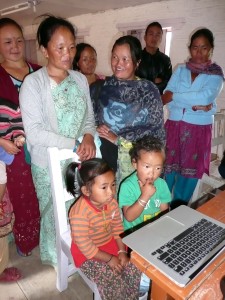There are upsides to having foreign medical providers volunteer at the clinic. It is an opportunity for continuing medical education not only for Lila and Rupa, but also Chitra the dental hygienist, the teachers, mothers group and community. Providers from other countries gain insight into the challenges of medical care in developing countries. Some commit to provide financial support and return on a regular basis to teach. A great example is a specialist in epilepsy came this past spring to lecture about epilepsy. People with epilepsy are marginalized in Nepal. She showed a Nepali made film debunking the myths surrounding seizures and had a tremendous response from the villagers. She continues to work with the Nepali Epilepsy Association and will return next year to continue her educational lectures.
There are negative impacts that are unintentional but can’t be ignored. Most of us can’t leave our practices for longer than a few weeks. For the majority of doctors in solo or group practices the burden of covering clinic hours, hospital admissions and night call falls to already fatigued colleagues. I was fortunate that my emergency medicine colleagues stepped up and covered my shifts for six weeks when I first went to Nepal, but that was all the time I could take. Factor in travel time, which ate up one week, and that’s a mere five weeks of coverage for the clinic.
Even well meaning volunteers lose interest or move onto other projects they consider more important, needy or of personal interest. It’s important to develop “stick-to-it-ness”. If you are thinking of volunteering no matter your occupation or experience, do the research. Know the organization before committing and ask yourself; “Why do I want to volunteer” and “What do I have to offer?” It’s not enough to want to do good…everyone wants to do good…stick that in your back pocket…what you need are skills and experience to be of value.
The language and cultural barriers lead to misunderstandings even when using local interpreters. During my first visit I couldn’t understand why villagers showed up at the volunteer house in the evenings for treatment when we had the clinic open for ten hours daily, six days a week. I was exhausted by nightfall and became annoyed, not wanting to treat minor ailments…until I finally understood these people had been working in their fields and could only come in the evenings.
Combine all these reasons and it adds up to sporadic, unreliable and inexperienced clinic staffing if you depend on outsiders. It also undermines the confidence in the local health-care workers (HCW) when we come as the experts and fosters delayed care when villagers wait for the “foreign” doctor to arrive instead of seeking care for serious problems from the local HCW. But most importantly it implies western medicine gets it right with respect to healthcare…and we don’t.
Can you think of other reasons it’s good or bad to have foreign health providers come to Nangi or any under-served country? Click on the comment tab and share your thoughts, as Jonni did last week. I’ll continue this topic next week with Mahabir’s version. Thank you to everyone for supporting my book blog this year…I cherish your comments and interest…wishing you all a wonderful holiday season.



I think you raise very good points. On my recent visit to Nangi I was astonished that epilepsy medications had been freely supplied by a visitor without a prior diagnosis or linkages to the Nepal Epilepsy Association, which can be readily done via the Telemedicine. There is a real risk of foreign medical and paramedical visitors practising their own type of ‘help’ believing that something is better than nothing, often doing what they would dare not do in their own country. The stakes are incredibly high for many of the villagers who do not have the benefit of health or social benefits to fall back on when ‘treatment plans’ go astray, especially those related to neurolgical conditions such as epilepsy – this condition is very much a stigmatised condition which really requires linkages to the NEA. To pose questions: what does the person do when they can’t afford more medication? (NEA can supply free); what considerations are there for a female prescribed certain epilepsy drugs should they be planning a pregnancy?; what about the potentially fatal rash that is about ten times more prevelant in asian patients that start some anti-epileptic drugs – who is monitoring this?; who is educating the person and their family on the safety issues around cooking, bathing etc?; who is educating the village on what epilepsy actually is so the person is not isolated and thought to be contagious or possessed? Who is monitoring the condition? I think the HCWs are ideally placed to support the person with the above questions. The role of the visitor ought to be to work *within their expertise* and make genuine ongoing connections with existing Nepal medical/social organisations so that their help does not just stop when they leave the village.
An example of good intentions that were not thought out or adapted to the local situation. A few years ago I had an interesting online debate with a well meaning tourist who decided to bring dental floss to villages while trekking in Nepal. They taught the people how to floss. Now I asked what happens when the floss is gone? What happens to the empty floss container? There is no place or money to buy floss in a remote village. There is no place to recycle the container. The well meaning tourist has created a want and need that can not be satisfied, along with pollution. I know…I was guilty of this myself during my first visit to Nangi…I brought 300 toothbrushes…and when I returned the next year I saw dozens strewn about the village. So I went to the local herbalist, Moti, and he showed me a shrub they used to clean their teeth. We started teaching about oral hygiene and took the school children to see the plant in the wild and showed them how to use it. An better example of finding a local answer to a local health issue.
Epileptic seizures result from abnormal, excessive or hypersynchronous neuronal activity in the brain. About 50 million people worldwide have epilepsy, and nearly 80% of epilepsy occurs in developing countries. –`,
My favorite internet site
http://www.healthdigest101.com